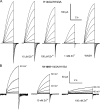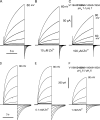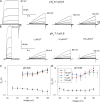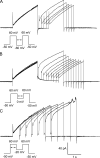Engineered high-affinity zinc binding site reveals gating configurations of a human proton channel
- PMID: 32902579
- PMCID: PMC7537347
- DOI: 10.1085/jgp.202012664
Engineered high-affinity zinc binding site reveals gating configurations of a human proton channel
Abstract
The voltage-gated proton channel (HV1) is a voltage sensor that also conducts protons. The singular ability of protons to penetrate proteins complicates distinguishing closed and open channels. When we replaced valine with histidine at position 116 in the external vestibule of hHV1, current was potently inhibited by externally applied Zn2+ in a construct lacking the two His that bind Zn2+ in WT channels. High-affinity binding with profound effects at 10 nM Zn2+ at pHo 7 suggests additional groups contribute. We hypothesized that Asp185, which faces position 116 in our closed-state model, contributes to Zn2+ chelation. Confirming this prediction, V116H/D185N abolished Zn2+ binding. Studied in a C-terminal truncated monomeric construct, V116H channels activated rapidly. Anomalously, Zn2+ slowed activation, producing a time constant independent of both voltage and Zn2+ concentration. We hypothesized that slow turn-on of H+ current in the presence of Zn2+ reflects the rate of Zn2+ unbinding from the channel, analogous to drug-receptor dissociation reactions. This behavior in turn suggests that the affinity for Zn2+ is greater in the closed state of hHV1. Supporting this hypothesis, pulse pairs revealed a rapid component of activation whose amplitude decreased after longer intervals at negative voltages as closed channels bound Zn2+. The lower affinity of Zn2+ in open channels is consistent with the idea that structural rearrangements within the transmembrane region bring Arg205 near position 116, electrostatically expelling Zn2+. This phenomenon provides direct evidence that Asp185 opposes position 116 in closed channels and that Arg205 moves between them when the channel opens.
© 2020 Cherny et al.
Figures












Comment in
-
Zn2+ to probe voltage-gated proton (Hv1) channels.J Gen Physiol. 2020 Oct 5;152(10):e202012725. doi: 10.1085/jgp.202012725. J Gen Physiol. 2020. PMID: 32910187 Free PMC article.
Similar articles
-
Histidine168 is crucial for ΔpH-dependent gating of the human voltage-gated proton channel, hHV1.J Gen Physiol. 2018 Jun 4;150(6):851-862. doi: 10.1085/jgp.201711968. Epub 2018 May 9. J Gen Physiol. 2018. PMID: 29743300 Free PMC article.
-
Hydrophobic gasket mutation produces gating pore currents in closed human voltage-gated proton channels.Proc Natl Acad Sci U S A. 2019 Sep 17;116(38):18951-18961. doi: 10.1073/pnas.1905462116. Epub 2019 Aug 28. Proc Natl Acad Sci U S A. 2019. PMID: 31462498 Free PMC article.
-
Molecular mechanism of Zn2+ inhibition of a voltage-gated proton channel.Proc Natl Acad Sci U S A. 2016 Oct 4;113(40):E5962-E5971. doi: 10.1073/pnas.1604082113. Epub 2016 Sep 19. Proc Natl Acad Sci U S A. 2016. PMID: 27647906 Free PMC article.
-
Analysis of an electrostatic mechanism for ΔpH dependent gating of the voltage-gated proton channel, HV1, supports a contribution of protons to gating charge.Biochim Biophys Acta Bioenerg. 2021 Nov 1;1862(11):148480. doi: 10.1016/j.bbabio.2021.148480. Epub 2021 Aug 5. Biochim Biophys Acta Bioenerg. 2021. PMID: 34363792 Free PMC article. Review.
-
Voltage-gated proton (H(v)1) channels, a singular voltage sensing domain.FEBS Lett. 2015 Nov 14;589(22):3471-8. doi: 10.1016/j.febslet.2015.08.003. Epub 2015 Aug 18. FEBS Lett. 2015. PMID: 26296320 Review.
Cited by
-
Biophysical Properties of Somatic Cancer Mutations in the S4 Transmembrane Segment of the Human Voltage-Gated Proton Channel hHV1.Biomolecules. 2025 Jan 21;15(2):156. doi: 10.3390/biom15020156. Biomolecules. 2025. PMID: 40001460 Free PMC article.
-
The voltage-sensing domain of a hERG1 mutant is a cation-selective channel.Biophys J. 2022 Dec 6;121(23):4585-4599. doi: 10.1016/j.bpj.2022.10.032. Epub 2022 Oct 29. Biophys J. 2022. PMID: 36815709 Free PMC article.
-
Discovery and characterization of Hv1-type proton channels in reef-building corals.Elife. 2021 Aug 6;10:e69248. doi: 10.7554/eLife.69248. Elife. 2021. PMID: 34355697 Free PMC article.
-
Cholesterol inhibits human voltage-gated proton channel hHv1.Proc Natl Acad Sci U S A. 2022 Sep 6;119(36):e2205420119. doi: 10.1073/pnas.2205420119. Epub 2022 Aug 29. Proc Natl Acad Sci U S A. 2022. PMID: 36037383 Free PMC article.
-
H+ and Confined Water in Gating in Many Voltage-Gated Potassium Channels: Ion/Water/Counterion/Protein Networks and Protons Added to Gate the Channel.Int J Mol Sci. 2025 Jul 29;26(15):7325. doi: 10.3390/ijms26157325. Int J Mol Sci. 2025. PMID: 40806455 Free PMC article. Review.
References
-
- Banh R., Cherny V.V., Morgan D., Musset B., Thomas S., Kulleperuma K., Smith S.M.E., Pomès R., and DeCoursey T.E.. 2019. Hydrophobic gasket mutation produces gating pore currents in closed human voltage-gated proton channels. Proc. Natl. Acad. Sci. USA. 116:18951–18961. 10.1073/pnas.1905462116 - DOI - PMC - PubMed

